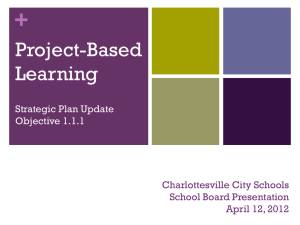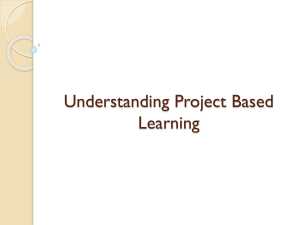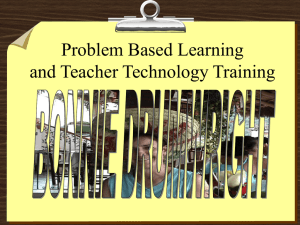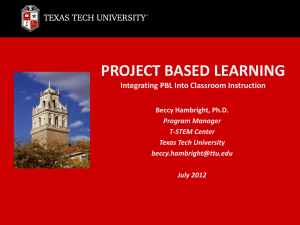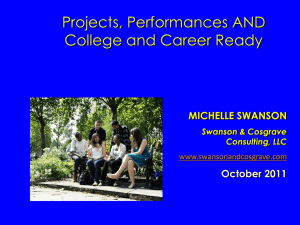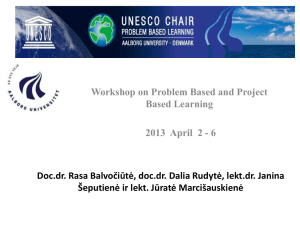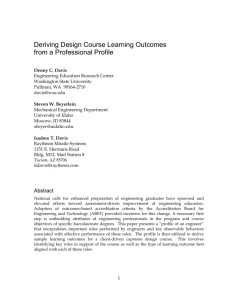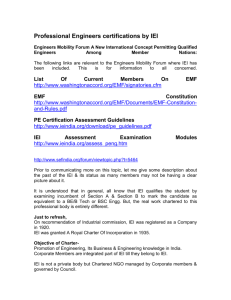The Engineer as a Professional
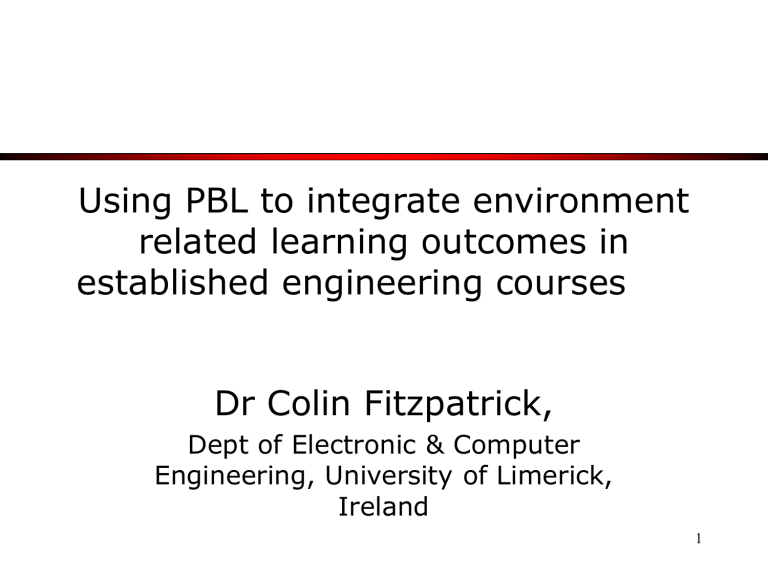
Using PBL to integrate environment related learning outcomes in established engineering courses
Dr Colin Fitzpatrick,
Dept of Electronic & Computer
Engineering, University of Limerick,
Ireland
1
Presentation Outline
• The Changing Responsibilities of Engineers
• IEI Accreditation
• Problem Based Learning
• Some Problems
• Grades & Feedback
• Conclusion
2
The Changing Responsibilities of an Engineer
• The Engineer should consider the protection of a client’s or employer’s interests his first professional obligation and therefore should avoid every act contrary to this duty”
– American Institute of Electrical Engineers
1912
3
The Changing Responsibilities of an Engineer
• Promote the principles and practices of sustainable development and the needs of present and future generations.
• Strive to ensure that engineering projects for which they are responsible will have minimal adverse effects on the environment, on the health and safety of the public and on social and cultural structures.
• Place responsibility for the welfare, health and safety of the community at all times before responsibility to the profession, to sectional interests, or to other engineers
– Engineers Ireland 2005
4
IEI Accreditation Report
2005
5
Electronic Engineering
6
Electronic Engineering
7
Electronic Engineering
8
IEI Accreditation Report
2009
• The core "Engineer as a Professional" module
[EE4003] was felt by the Panel to be an excellent addition to the programme since the last accreditation panel visit, and its teamwork development activity in particular was felt to be a model of good practice that could be promulgated as such within the sector.
• The Electronics & the Environment module
[ET4407] was also noted as a very positive addition to the programme, although not contributing to the Programme Outcomes for every student on the programme because of its position as an elective module.
9
New BE Electronic Engineering
Semester 6
EE4317
Active Circuits 4
ET4224
Sensors &
Actuators
EE4816
Signals &
Systems 1
EE4617
Communications
Theory 1
EE4218
Control 2
Semester 7
EE4407
ASICs 1
EE4607
Telecommunications
Systems 1
ET4407
Electronics &
Environment
EE4005
Electrical Power
Systems
EE4907
Final Year Project 1
Semester 8
EE4408
ASICs 2
CE4008
VLSI DSP Systems
EE4328
Power Electronics
EE4117
Electromagnetics
EE4908
2
Final Year Project
Syllabus
• 1. Environmental Forces in the Electronics Industry -Market
Driven -Sustainability Driven - Legislation Driven
• 2. Design for Environment (ECO Design), -Life Cycle Chain
Analysis, -Design for Recycling -Reverse Manufacturing, -
Reverse Logistics -End of Life Solutions
• 3. Green Materials, -Lead Free Interconnects, -Halogen Free
Materials, -All other materials outlined in WEEE and ROHS, -
Packaging
• 4. Sustainability, -Energy Efficiency, -Alternative Power
Supply
• 5. Case Studies discussing such issues as Environmental
Challanges in the Semiconductor Industry, Producer
Responsibility in Electronics Industry & Sustainable Trade in the Electronics Sector of Emerging Economies among other topics.
• 6. Invited Talks -Seminars By The Local Electronics Industry
On Environmental Challenges In Their Company.
11
How PBL is Applied
• The module is divided into weekly problems posted on the module blog
• The students must solve in groups of three or four
• Each group has a chair, a scribe and a timekeeper
• During this session they must
– Name facts
– Clarify what they think the problem is
– Brainstorm ideas based on prior knowledge
– Identify what they do not know (learning issues)
– Specify an action plan and assign tasks
12
How PBL is Applied
• In the second session of the week they share information and resources, and peer-teach their proposed solution to the problem
• This period is crucial to make sure that they what they are working on is relevant
13
How PBL is Applied
• In the final session of the week a representative of each group makes a presentation to the class on their solution to the problem
• The students also have an opportunity to ask questions and discuss
• The lecturer gives an overview of the topic and feedback on the presentations
• They must write an individual blog entry on the problem
14
15
16
17
18
19
20
21
22
23
24
Capstone Project
25
26
Capstone Project
• Thin client system based out of the community center and or library. This is energy and materials efficient and also of social value.
• Thin clients are less attractive to thieves.
• Thin clients available for home use if required after training has been completed.
• Don’t just roll out a machine for everyone, make sure that the hardware is available but that it is used efficiently
• Thick clients also available for home use if need is justified
• System of accountability and responsibility for hardware needed
27
Capstone Project
• Machines should be free but have a small rental / subscription to make sure that they are being used. If they are not being used then they can be handed back.
• Detailed and comprehensive training programs required based on demographics
• The whole area must be broadband enabled either through wireless or fixed line
• Long term commitment to the project maintenance required.
• The social and economic cost of not doing the project outweighs the economic cost of undertaking it.
28
Capstone Project
• An area should be established to allow small businesses become established which can take advantage of the excellent IT infrastructure
• Violent and other anti-social websites should be kept outside a firewall
• Residents should be part of the management and operational running of the project
• Use the most energy efficient servers available (several spec’s given)
• Develop a website on local environmental / ecological issues
29
Capstone Project
• Promote the internet as a means of reducing car dependency
• Must establish a philosophy of repairing all equipment where possible
• All upgraded equipment must be reused elsewhere
• Develop an on-line local newsletter
• Recycling should be a key part of all operations
• Choice of operating systems should be available. Open source is cheaper but for training purposes Microsoft should also be available due to its dominant role in industry.
30
Capstone Project
• All printers should be eco labeled and print double sided using recycled paper.
• All monitors should have LED backlights
• All new buildings should have the best in environmental technology to showpiece environmental thinking
• All lighting in the training / drop in centres should be energy efficient
• Servers should be powered using renewable energy
• Marketing campaign should surround the scheme to create a positive image of the area in the national media.
31
Capstone Project
• The community should be given the opportunity to air their views on how the scheme should evolve over time.
• The plan must be adaptable.
• The scheme should tie in with Computer Science and
Engineering Departments at local Third Level colleges.
• Training should be more than just ECDL and typing, should have continuation courses for web development, databases, programming, computer games development,
CAD etc…
• Targets set for increasing the level of IT skills, increasing
IT related employment and increasing literacy and numeracy.
32
Grades
25
20
15
10
5
0
40
2007 (PBL w ith Continuous As s e s s m e nt) v
2006 (Te rm inal Exam )
35
30
A1 A2 B1 B2 B3 C1 C2 C3 D1 D2 F
Grade
2007
2006
33
Feedback
• “I believe the PBL approach teaches the material more thoroughly. I feel this is because we were required to research the topics and then create a paper based on this research. Working in groups was helpful as this allowed us to confer with each other and learn more, this also improved our team skills.
I believe there will be a longer retention of the material due to the PBL approach. Personally I prefer the PBL approach.”
34
Feedback
• “Found it to be much better. I found I learned far more using this approach.”
• “This method is a lot easier to understand as we are putting the information learned directly into use so it remains more active for longer”
35
Feedback
• “The module is an interesting one and it is also taught in a good way. By sending us off to research required material ourselves I feel the information acquired through this process definitely stays with the student, more so than studying notes that have been provided for you to study by lecturers in other modules”
36
Conclusion
• Cover significantly more material
• Students are much more engaged
• Students produce work of a much higher quality
• It’s more enjoyable for me
37

